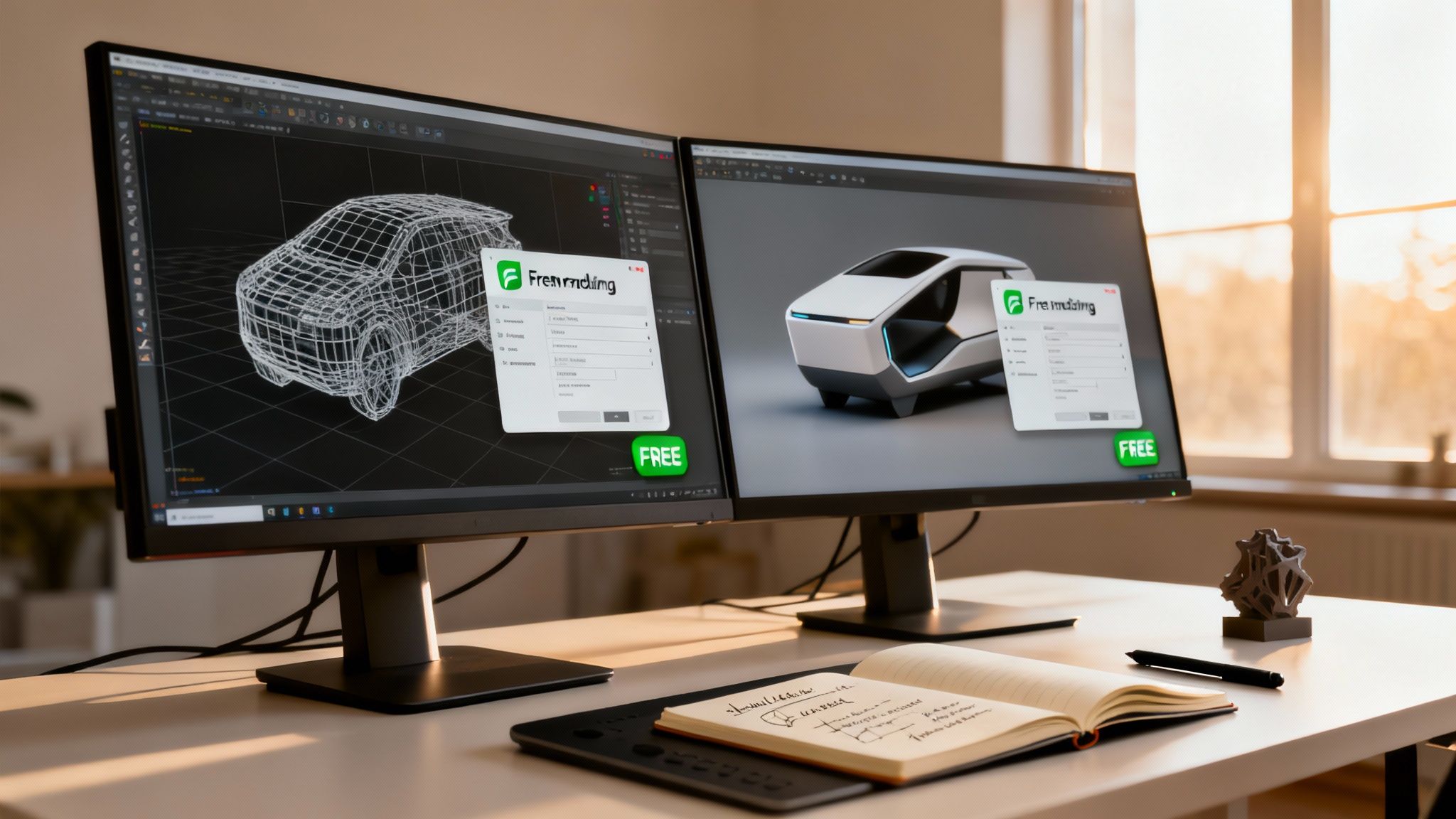In today's competitive visual landscape, creating photorealistic 3D renders is crucial for everything from product design to cinematic animation. High-end rendering was once the exclusive domain of large studios with massive budgets. Today, a powerful ecosystem of render programs free for commercial and creative use has democratized this technology. This guide is designed for enterprise creative teams, game developers, and solo artists seeking compliant, safe, and powerful rendering solutions without the hefty price tag. We will explore 12 of the best free options, analyzing their real-world use cases, honest limitations, and implementation considerations to help you make an informed decision that aligns with professional production standards.
We'll examine how each tool, from established giants like Blender and Unreal Engine to specialized solutions like LuxCoreRender and MoonRay, fits into a modern creative workflow. Each entry includes direct download links and key specifications, ensuring you can quickly assess compatibility and start creating. For those looking to push their creative boundaries, exploring resources like AI prompts for 3D rendering can provide innovative starting points for complex projects. Our goal is to provide a clear, practical roadmap to help you select the ideal free rendering engine, ensuring your projects are not only visually stunning but also built on a secure and scalable foundation.
1. Blender (Cycles and EEVEE)
As the undisputed leader in the open-source 3D space, Blender offers a complete creative suite, making it one of the most powerful render programs free of charge. Its true strength lies in its two integrated yet distinct render engines: Cycles, a robust path-tracing engine for photorealistic results, and EEVEE, a real-time rasterization engine for instant feedback and stylized renders. This dual-engine approach provides unparalleled flexibility for any project.
Cycles excels at producing physically accurate lighting, complex caustics, and detailed material shaders, making it ideal for final architectural visualizations, product shots, and VFX. EEVEE, on the other hand, is perfect for look development, pre-visualization, and projects requiring a non-photorealistic or game-engine aesthetic. The constant development, backed by a huge global community, ensures that Blender remains a cutting-edge, enterprise-ready tool. For an in-depth look at its capabilities, you can find detailed guides on rendering and animation with Blender.
- Best for: Independent artists, studios of all sizes, and professionals seeking a comprehensive, commercially viable, and entirely free 3D production pipeline.
- Pros: Completely free for any use, a large community, and two powerful built-in render engines.
- Cons: EEVEE can be demanding on VRAM, and integrating Blender into established professional pipelines might require custom add-ons or scripting.
2. Pixar RenderMan (Non-Commercial)
For artists aspiring to work in high-end VFX and feature animation, Pixar's RenderMan offers a direct pathway to learning a studio-grade tool. Available as one of the most powerful render programs free for non-commercial use, it provides the exact same robust feature set used on major motion pictures. RenderMan includes its advanced XPU engine, which seamlessly combines the power of both CPU and GPU for accelerated path-traced rendering, offering incredible flexibility during production.
This non-commercial version is not a stripped-down trial; it's the full, production-proven renderer trusted by major studios. It comes with official plugins for industry-standard software like Maya, Houdini, and Blender, allowing for easy integration into existing workflows. By using it, artists can master the same lighting and shading techniques used to create film-quality, photorealistic imagery. The only major restriction is its use for personal projects, learning, and research, making it an invaluable educational resource for anyone serious about a career in CGI.
- Best for: Students, aspiring professionals, and artists looking to learn and master a top-tier, industry-standard rendering pipeline for personal projects.
- Pros: Access to a genuine, industry-proven renderer for free, and an excellent opportunity to build portfolio work with a studio-quality tool.
- Cons: License is strictly non-commercial and requires renewal every 120 days, which involves a simple online process.
3. LuxCoreRender
For those prioritizing physical accuracy above all else, LuxCoreRender stands out as a premier open-source rendering engine. It is an unbiased, physically based renderer that excels at simulating complex, realistic light transport. This makes it one of the most capable render programs free for scenes demanding high-fidelity lighting effects like intricate caustics, volumetric scattering, and subtle light bounces. Its core strength is its commitment to realism, often producing results that are difficult to distinguish from photographs.
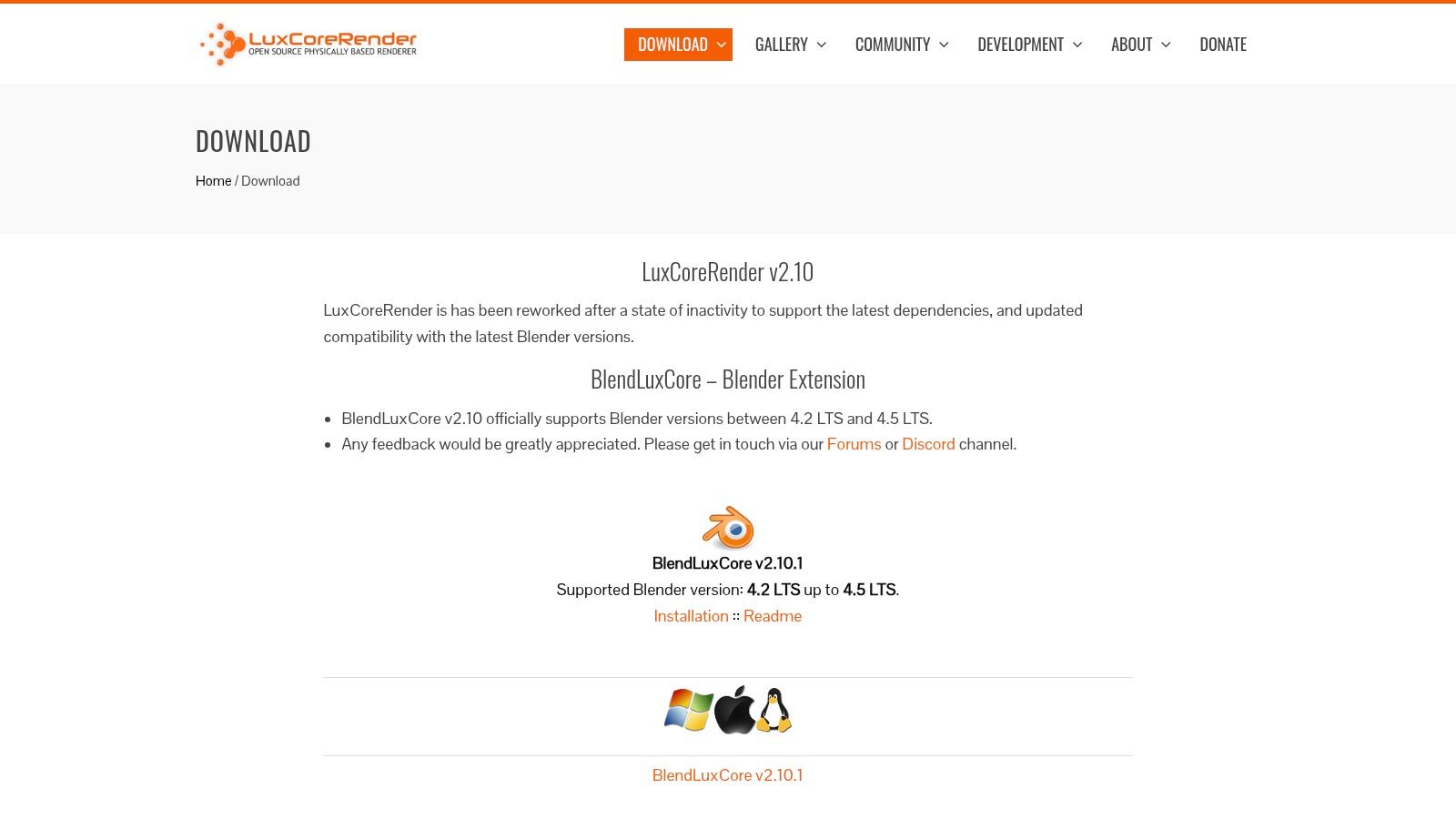
While it can operate as a standalone application, LuxCoreRender is most accessible through its robust Blender integration, BlendLuxCore, which supports the latest LTS versions. It leverages both CPU and GPU (via OpenCL/CUDA) power, providing flexibility for different hardware setups. The engine is a fantastic choice for architectural visualization, scientific simulation, and any project where light behavior must be flawlessly replicated. You can find out more about the benefits of using these types of free software for rendering to achieve enterprise-level quality.
- Best for: Architects, product designers, and VFX artists requiring the highest degree of photorealism, especially in scenes with complex lighting.
- Pros: Exceptional realism with advanced light simulation, completely free for commercial use, and flexible CPU/GPU rendering options.
- Cons: Has a steeper learning curve and a smaller community than Cycles, and requires more technical setup for standalone use outside of Blender.
4. AMD Radeon ProRender
Developed by AMD, Radeon ProRender is a powerful, physically-based rendering engine offered as one of the most compelling render programs free for commercial use. It provides open-source plugins for popular DCC applications like Blender, Maya, and Houdini, leveraging hardware-accelerated ray tracing on modern Radeon GPUs. Its commitment to open standards like MaterialX and its integration with Universal Scene Description (USD) pipelines make it a forward-thinking choice for modern production environments.
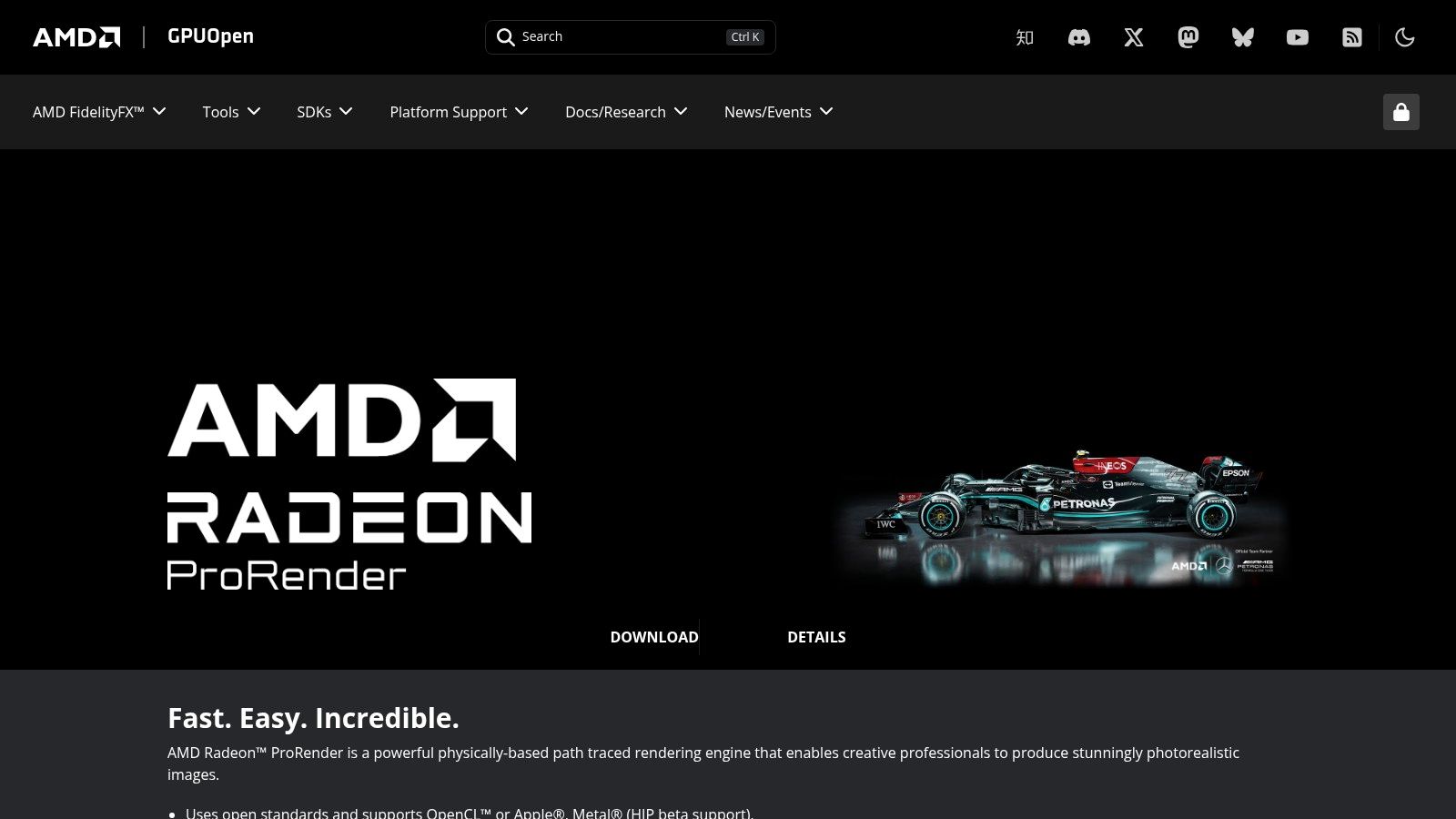
As a cross-platform solution supporting Windows, macOS, and Linux, ProRender ensures flexibility across different operating systems and hardware setups. Its high-performance rendering is particularly effective for creating stunning visuals, a key aspect detailed in guides about 3D product rendering. The provided SDK also allows developers to integrate the engine directly into their custom software, offering a high degree of extensibility for technical teams.
- Best for: Artists and studios using AMD hardware, developers needing a robust rendering SDK, and teams invested in open-standard workflows like USD/Hydra.
- Pros: Completely free for commercial use, excellent integration with AMD hardware, and strong support for open standards.
- Cons: Performance and feature parity can vary significantly between different DCC plugins and GPUs, and its user base is smaller than more established renderers.
5. Intel oneAPI Rendering Toolkit (Render Kit)
While not a standalone application, the Intel oneAPI Rendering Toolkit is a powerful collection of high-performance rendering libraries that serve as the engine behind many industry-standard render programs free and commercial. This suite provides developers and technical artists with the core components to build or enhance custom rendering solutions. Its primary libraries include OSPRay, a high-fidelity, ray-tracing engine, Embree for optimized ray-tracing kernels, and Open Image Denoise, a machine-learning-based denoiser used by Blender and others.
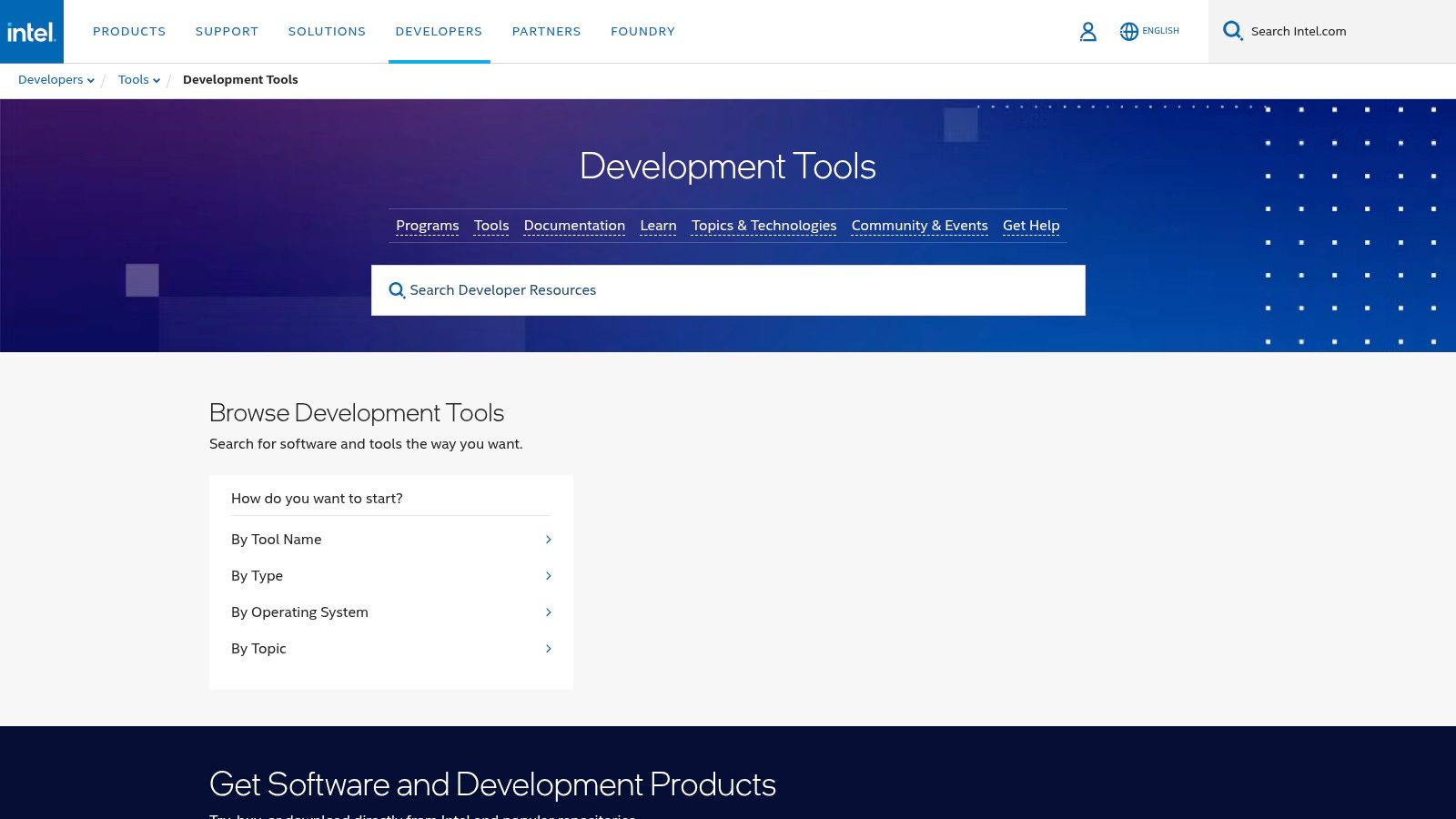
This toolkit is designed for performance and scalability, particularly for scientific visualization, data analysis, and creating photorealistic content where efficiency is paramount. Its modular nature means you can integrate only the parts you need, such as adding the world-class denoiser to an existing pipeline. By providing these production-proven tools under an open-source license, Intel empowers creators to build sophisticated, high-performance rendering workflows without licensing costs, ensuring a safe and compliant option for enterprise-level development.
- Best for: Developers, technical directors (TDs), and studios looking to build custom renderers or integrate high-performance rendering and denoising components into existing pipelines.
- Pros: Completely free, industry-proven components, and highly modular for selective integration.
- Cons: Not an end-user DCC application; requires programming knowledge to implement and use effectively.
Get Intel oneAPI Rendering Toolkit
6. NVIDIA Omniverse
NVIDIA Omniverse is a powerful real-time collaboration and simulation platform built on Pixar's Universal Scene Description (USD), offered as one of the most advanced render programs free for individual creators. Its core is a live-sync environment where artists can connect major DCC applications like 3ds Max, Maya, and Unreal Engine into a single, interactive scene. The platform leverages NVIDIA's RTX technology to deliver stunning, real-time path-traced rendering, collapsing the traditionally slow iteration cycle.
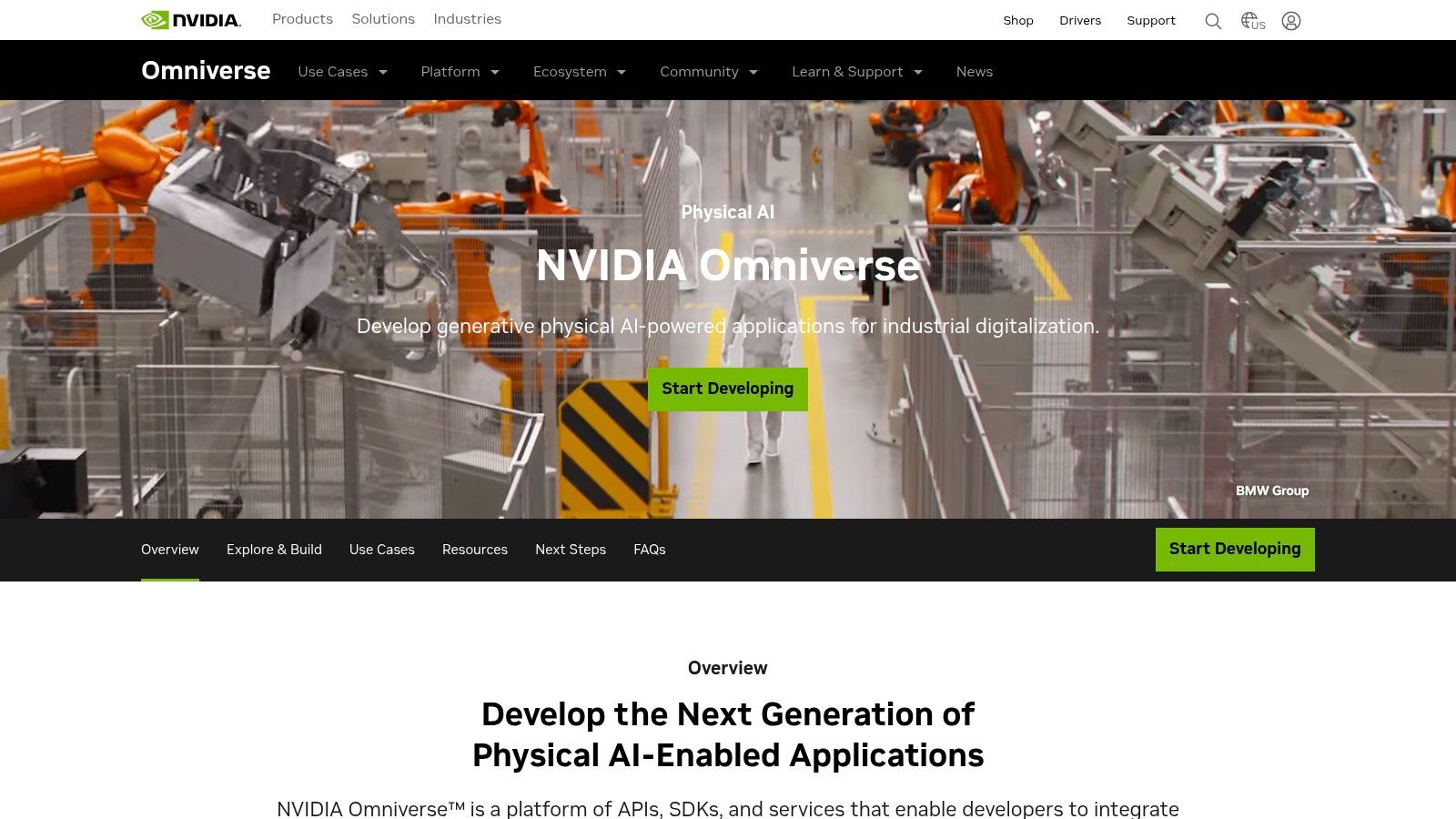
This connected workflow, powered by the Nucleus server, allows multiple artists using different software to work on the same project simultaneously, seeing each other's changes instantly. This makes it an exceptional tool for collaborative teams in VFX, architecture, and game development seeking to unify their disparate pipelines. For enterprises, Omniverse presents a scalable, secure foundation for building custom 3D workflows and digital twins, though some advanced features are reserved for paid plans.
- Best for: Individual creators, freelance artists, and small teams needing a unified, real-time, multi-app workflow with high-fidelity RTX rendering.
- Pros: Cutting-edge real-time path tracing is free for individuals, and it revolutionizes collaborative workflows across different software.
- Cons: Requires modern NVIDIA RTX hardware for optimal performance, and enterprise-level collaboration features require a paid subscription.
7. OTOY OctaneRender Prime (free tier) / Octane X (Mac)
OTOY democratizes high-end GPU rendering by offering OctaneRender Prime, a free tier of its renowned unbiased, physically-based engine. This makes it one of the most powerful render programs free for individuals looking to achieve true photorealism without an initial investment. OctaneRender is celebrated for its incredible speed, leveraging NVIDIA GPUs (or AMD/Intel on Mac via Octane X) to produce stunningly realistic lighting and materials with breathtaking efficiency.
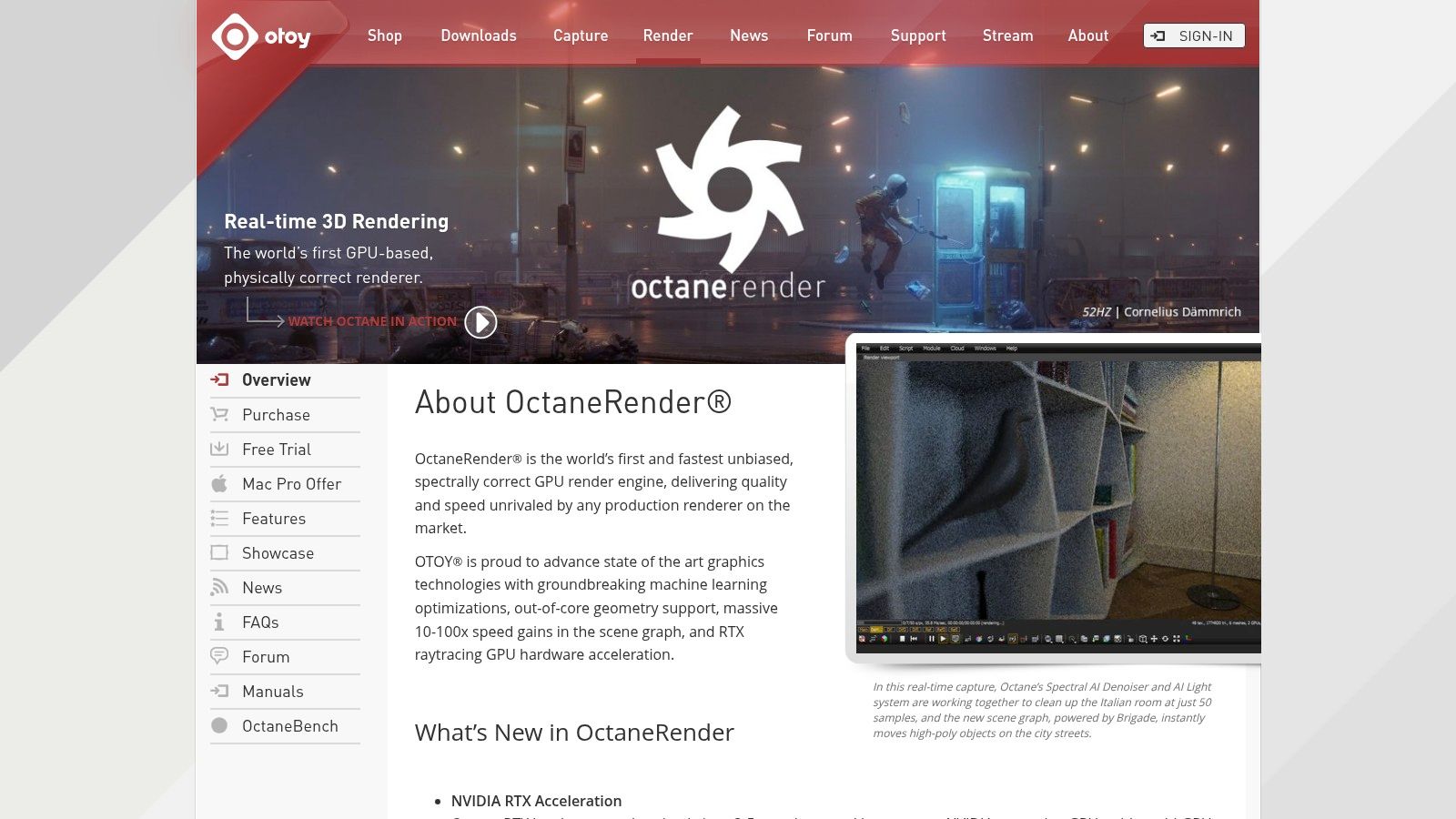
The free Prime version is fully functional for both personal and commercial projects, offering access to the standalone edition and a free plugin for one DCC application of your choice. While the free tier limits you to a single GPU and lacks some advanced features like network rendering, it serves as an excellent, enterprise-grade entry point into the OTOY ecosystem. It allows artists and small studios to learn and integrate a top-tier GPU renderer into their workflow before scaling up to paid plans.
- Best for: Individuals, students, and freelancers who need a production-proven, unbiased GPU renderer for photorealistic results without the upfront cost.
- Pros: Truly photorealistic GPU rendering at no cost, provides a direct upgrade path to paid tiers and cloud services for larger projects.
- Cons: The free tier is limited to a single GPU, requires account registration, and network or multi-GPU rendering are paid features.
8. Unreal Engine
While primarily known as a AAA game engine, Unreal Engine has rapidly evolved into a powerhouse for cinematic and virtual production, making it a formidable entry among render programs free for many users. It features two groundbreaking rendering systems: Lumen, a fully dynamic real-time global illumination and reflections system, and an offline-quality Path Tracer. This combination allows artists to achieve stunning photorealism instantly, eliminating the long wait times associated with traditional offline rendering.

Unreal Engine is free to download and use for learning, internal projects, and commercial products until they generate over $1 million in lifetime gross revenue. This model makes it incredibly accessible for independent creators, architectural visualization artists, and filmmakers to leverage enterprise-grade tools. The engine's Movie Render Queue provides extensive control over final cinematic output, while its vast marketplace and active community offer robust support and resources for any production scale.
- Best for: Virtual production studios, architectural visualization artists, and game developers needing top-tier real-time rendering and cinematic output without initial investment.
- Pros: Free for learning and for commercial use below the revenue threshold, industry-leading real-time visual quality, and a massive ecosystem of assets and tools.
- Cons: Royalty conditions apply for commercial products exceeding $1M in revenue, and advanced features like Lumen and Path Tracing require powerful, high-end hardware.
Get Unreal Engine
9. Godot Engine
While primarily known as a game engine, Godot offers a surprisingly capable real-time 3D rendering pipeline that makes it an excellent, lightweight choice among render programs free for download. Its completely open-source, MIT-licensed model means there are no royalties or hidden fees, providing full creative and commercial freedom. The engine's renderer is optimized for speed and is particularly well-suited for creating stylized, non-photorealistic visuals for games, interactive applications, and pre-visualization tasks.
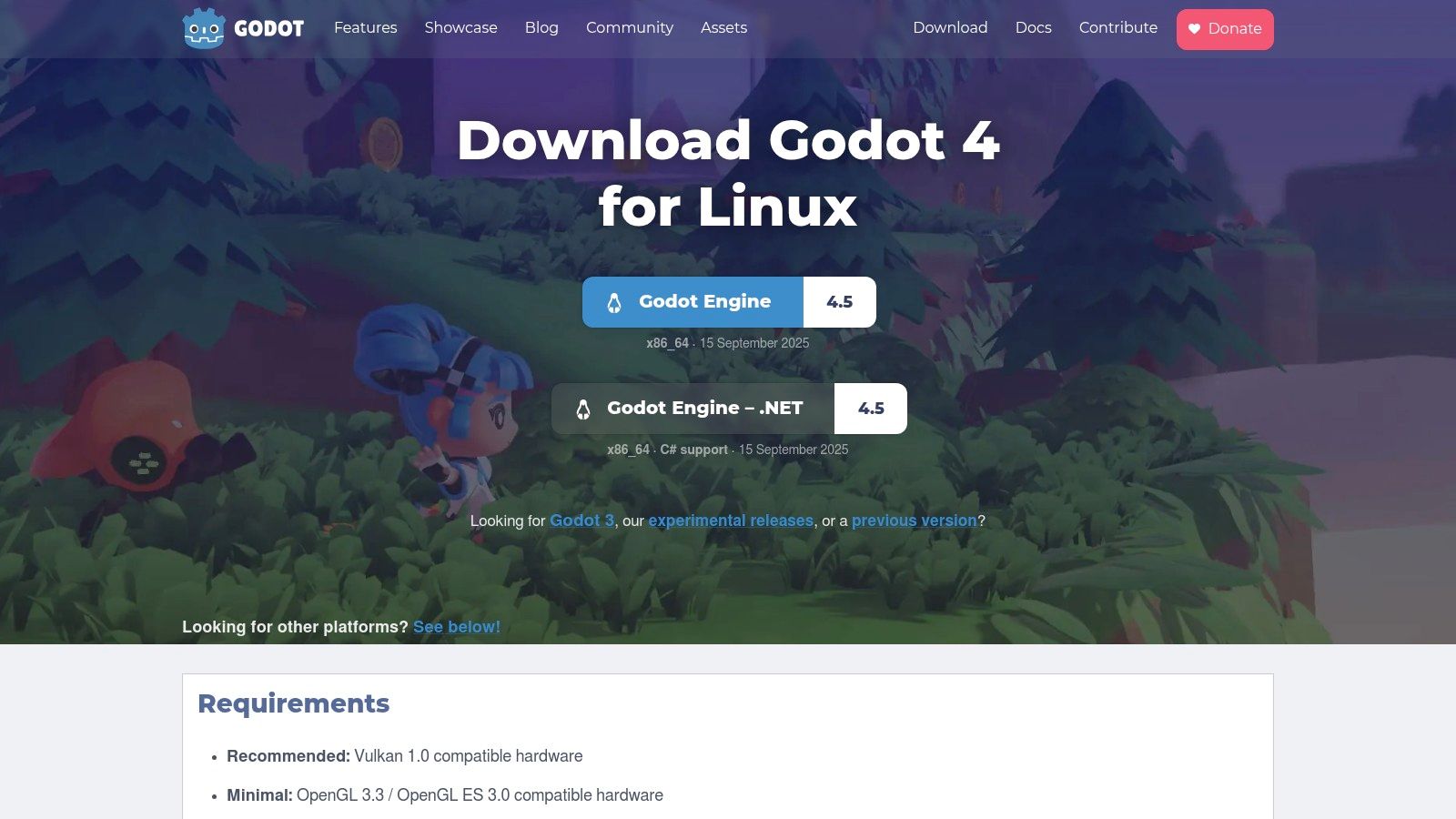
Godot's strength lies in its simplicity and accessibility, making it a great platform for learning the fundamentals of real-time rendering without the steep learning curve of more complex engines. Its flexible pipeline and extensive export options allow users to deploy their interactive scenes to desktop, mobile, and web platforms with ease. The community-driven development ensures that the engine is constantly evolving, with a strong focus on usability and performance. It stands out as a highly approachable tool for developers and artists focused on real-time output.
- Best for: Game developers, interactive artists, and individuals seeking a lightweight, scriptable real-time engine for stylized or non-photorealistic projects.
- Pros: Entirely free with no royalties, lightweight and easy to script, and boasts a fully open, community-driven governance model.
- Cons: Not designed for high-fidelity offline path tracing, and its 3D toolset is less extensive than larger engines like Unreal or Unity.
10. D5 Render (Community edition)
D5 Render has rapidly emerged as a powerful real-time ray tracing renderer, particularly for architectural visualization, and its free Community edition makes it one of the most accessible render programs free for individuals. It leverages real-time global illumination and reflection technology to produce stunning, photorealistic results with incredible speed, bridging the gap between quality and efficiency. The platform simplifies complex rendering processes with an intuitive, game-engine-like interface and seamless LiveSync integration with popular modeling software like SketchUp, 3ds Max, and Revit.
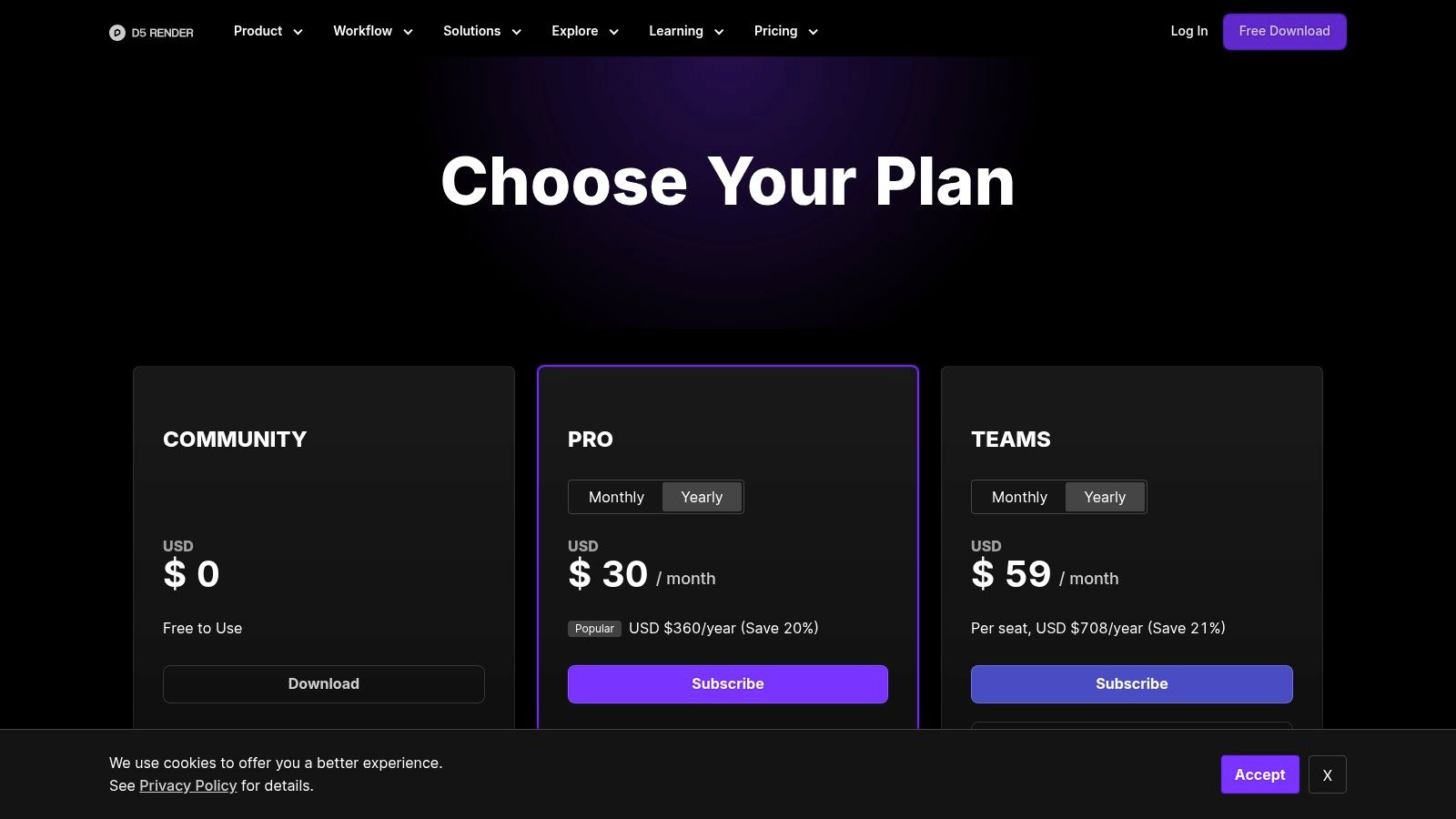
The free Community edition is remarkably generous, offering unlimited 16K still image exports, access to a foundational asset library, and essential path animation tools. This makes it a fantastic starting point for students, freelancers, and small teams looking to produce high-quality archviz content without an initial investment. While the Pro version unlocks a much larger asset library and advanced video export options, the free tier provides all the core functionality needed to create professional-grade visuals.
- Best for: Architects, interior designers, and students needing a fast, easy-to-learn real-time renderer for personal projects and portfolio development.
- Pros: Extremely fast and intuitive archviz workflow, generous free plan with high-resolution still exports.
- Cons: The largest asset libraries and advanced video outputs require a paid subscription, and it is Windows-centric, demanding a high-end RTX GPU for optimal performance.
11. POV-Ray (Persistence of Vision Ray Tracer)
As a foundational tool in the history of computer graphics, POV-Ray (Persistence of Vision Ray Tracer) stands out as a unique, script-driven ray tracing engine. Unlike modern GUI-based applications, POV-Ray scenes are defined entirely through a text-based Scene Description Language (SDL). This makes it one of the most interesting render programs free for those who want to understand rendering at a fundamental level or require a highly deterministic, scriptable rendering pipeline for scientific visualization or procedural art generation. Its core strength lies in its precision and predictability, producing mathematically perfect results from code.
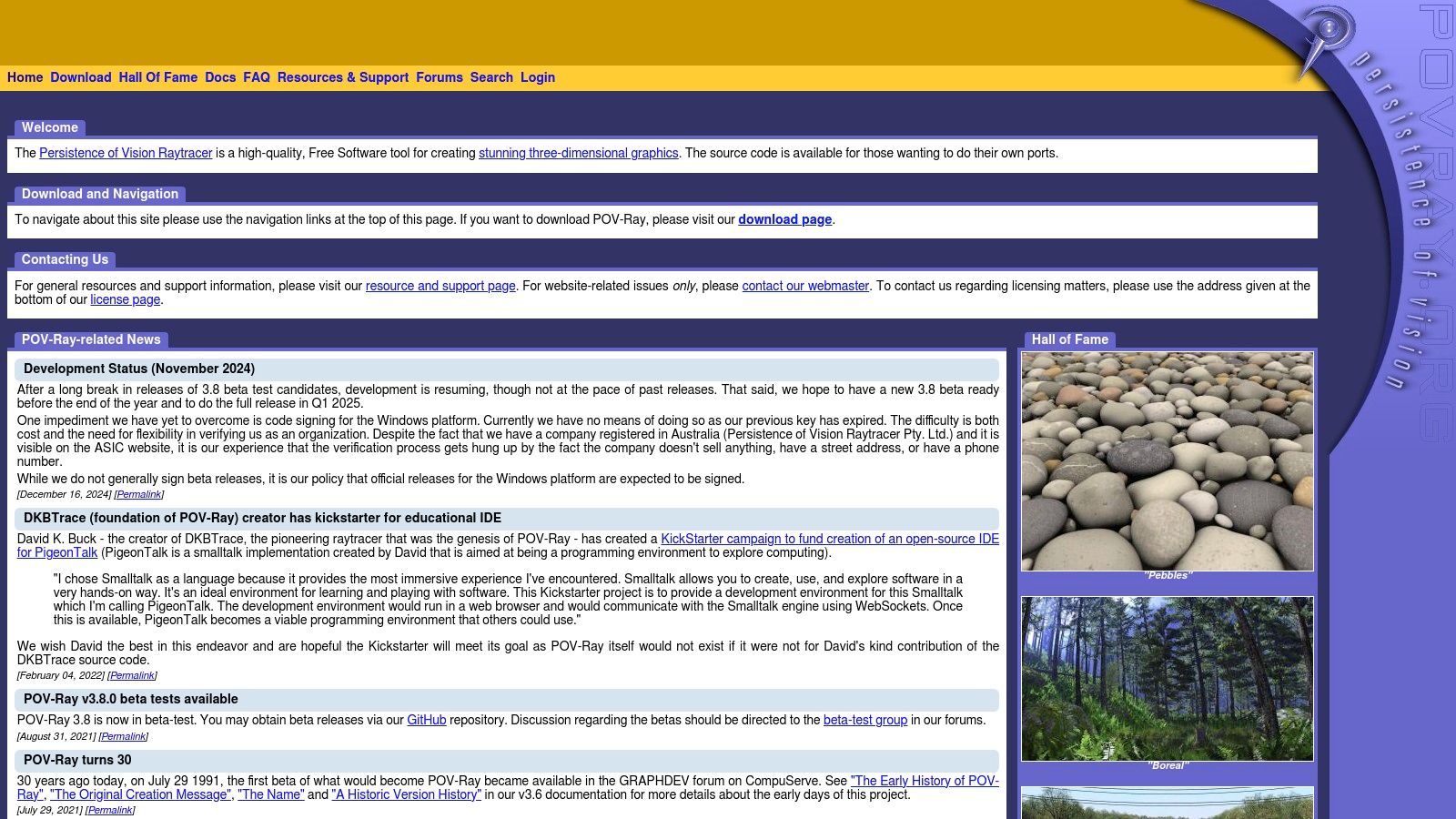
While it lacks the real-time feedback and node-based workflows of contemporary software, POV-Ray is an excellent educational resource for learning the principles of ray tracing. Its lightweight nature and cross-platform compatibility mean it can run on virtually any system, making it accessible to everyone. For developers and technical artists, it offers a powerful way to generate complex imagery through algorithms and scripts, bypassing the limitations of manual modeling. It remains a powerful tool for mathematical art and niche scientific applications where absolute precision is paramount.
- Best for: Students, educators, programmers, and technical artists interested in the core principles of ray tracing or creating procedurally generated art.
- Pros: Completely free and open-source, excellent for educational purposes, lightweight and cross-platform.
- Cons: Steep learning curve due to its text-based nature, lacks a modern GUI or real-time viewport, and has a much smaller community than mainstream tools.
12. MoonRay (DreamWorks’ OpenMoonRay)
For studios and technical artists seeking production-proven rendering power, DreamWorks Animation has open-sourced its in-house Monte Carlo ray tracer, MoonRay. This is the same engine used on blockbuster films, making it one of the most powerful and professionally vetted render programs free for public use. It delivers state-of-the-art, physically based rendering and is built for large-scale, collaborative pipelines.

MoonRay's key strength is its deep integration with modern VFX workflows, particularly through its USD Hydra delegate. This allows it to plug directly into compatible applications like Autodesk Maya and Foundry Katana. It also includes the Arras framework for distributed multi-machine rendering, enabling users to leverage render farms for complex shots. While it requires significant technical expertise to compile and integrate, its open-source nature provides unparalleled control for studios building custom, enterprise-level pipelines.
- Best for: Technical directors, pipeline engineers, and VFX studios needing a powerful, customizable, and battle-tested rendering core for integration into existing workflows.
- Pros: Studio-grade rendering technology is openly available, active development and releases, and built for distributed rendering across multiple machines.
- Cons: Requires advanced technical skill to build, install, and integrate; not a user-friendly, out-of-the-box solution for individual artists.
Top 12 Free Render Programs Comparison
Choosing Your Next Renderer and Unifying Your Workflow
The journey through the world of free rendering software reveals a landscape rich with powerful, enterprise-ready options. We've explored comprehensive solutions like Blender, with its integrated Cycles and EEVEE engines, and industry-standard powerhouses like Pixar's non-commercial RenderMan. From the real-time capabilities of Unreal Engine to the specialized, physically-based accuracy of LuxCoreRender, the right tool for your project is available without a significant financial investment.
The sheer variety of these render programs free to use means that a one-size-fits-all approach is no longer necessary or efficient. The best choice for your team hinges on a careful evaluation of your specific creative and operational needs.
Making the Right Choice for Your Pipeline
Selecting the ideal renderer requires looking beyond a simple list of features. Your decision should be a strategic one, informed by several key factors that directly impact your team's efficiency and creative output.
Consider these critical questions:
- Project Scope & Style: Are you creating photorealistic architectural visualizations, stylized character animations, or fast-paced game environments? A tool like D5 Render excels at archviz, while Godot or Unreal Engine is built for interactive experiences.
- Hardware Ecosystem: Do your workstations rely on NVIDIA, AMD, or Intel processors and GPUs? Solutions like AMD Radeon ProRender and the Intel oneAPI Rendering Toolkit are optimized for their respective hardware, while NVIDIA Omniverse leverages the RTX platform for complex collaborative workflows.
- Team Expertise: Does your team have deep experience in a particular DCC like Maya or 3ds Max, or are they digital-native Blender users? Choosing a renderer that integrates smoothly with your primary modeling software will significantly reduce friction and training time.
- Workflow Integration: How will the renderer fit into your broader pipeline? Open-source options like MoonRay or POV-Ray offer immense flexibility for custom integration, which is a key consideration for studios with dedicated technical directors.
Unifying Your Creative Assets
Once you’ve selected one or more of these powerful render programs free of charge, the next challenge emerges: managing the assets they produce. A modern creative workflow is rarely linear. It involves 3D models, multiple render passes, video edits, AI-generated concepts, and feedback from various stakeholders. This diverse collection of digital assets can quickly become disorganized, leading to version control issues and slowing down the entire creative process.
This is where a unified workspace becomes essential. Instead of juggling files across different storage platforms and communication channels, a centralized system provides a single source of truth. It allows your team to view 3D models, review renders, and collaborate on final composites in one cohesive environment. Extending your 3D workflow beyond digital rendering can involve preparing models for physical fabrication. For those interested in this next step, exploring these general 3D printing guides can provide valuable insights into turning digital creations into tangible objects.
Ultimately, the goal is to create a seamless pipeline where your chosen rendering software is just one powerful component in a larger, well-organized creative ecosystem. By carefully selecting your tools and implementing a robust asset management strategy, you empower your team to focus on what they do best: creating stunning visuals.
Ready to unify your creative workflow and manage assets from any renderer in one place? Discover how Virtuall, the AI-powered Creative OS, centralizes your 3D models, renders, and AI-generated content to streamline collaboration and accelerate your pipeline. Try Virtuall today and take control of your creative process.


